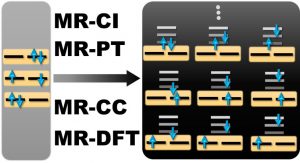The date and place for the Midlands Computational Chemistry Meeting 2019 are fixed. The meeting will take place on 15 April 2019 at Loughborough University in West Park Teaching Hub. You can find the details here.
Paper: Two-Photon Polymerisation Initiators
A joint experimental and computational study with groups from Vienna and Geneva just appeared in Sci. Rep.: “Wavelength-optimized Two-Photon Polymerization Using Initiators Based on Multipolar Aminostyryl-1,3,5-triazines.” In this paper, the two-photon absorption properties of a new class of aminostyryl-triazines were investigated showing good agreement between experiment and computation. Furthermore, the practical applicability of these molecules for 3D-printing was shown.
Paper: Dynamics within an Exciton Model
Another paper working on improving the efficiency of surface hopping dynamics just appeared, this time in JCTC: “Surface hopping within an exciton picture – An electrostatic embedding scheme.” authored by M. F. S. J. Menger, F. Plasser, B. Mennucci, and L. González. In this paper, we explored the possibility of running nonadiabatic dynamics simulations within an exciton model. The main challenge in this endeavour was to derive a consistent energy expression for combining QM/MM electrostatic embedding calculations of the different chromophores.

To test the implementation, we ran simulations on a molecular dyad, where full TDDFT nonadiabatic dynamics simulations were available. Good agreement was found.
The method was implemented in the SHARC molecular dynamics package.
Paper: Highly-efficient photodynamics simulations
A new paper co-authored by F. Plasser just appeared in PCCP: “Highly efficient surface hopping dynamics using a linear vibronic coupling model.” The paper shows that it is possible to perform photodynamics simulations of nonadiabatic processes, such as internal conversion and intersystem crossing, at virtually no cost.
Book Chapter: Trajectory Surface Hopping
The book chapter “General Trajectory Surface Hopping Method for Ultrafast Nonadiabatic Dynamics” written by S. Mai, F. Plasser, P. Marquetand, and L. González of the book Attosecond Molecular Dynamics edited by M. J. J. Vrakking and F. Lepine just appeared online. Download and read it if you are interested in getting an introduction into nonadiabatic surface hopping dynamics.
Highlight in ChemistryViews
Felix’ talk at the EuCheMS conference in Liverpool was highlighted in ChemistryViews. You can find the article here (scroll down to the blue box).
Talk at QBIC IV in Bath
On 5 September, Felix Plasser will give a talk entitled “Transition Metal Complex Excited States: Turning Numbers into Chemical Insight” at the Quantum-Bio-Inorganic Chemistry Conference IV in Bath. The talk will discuss the automatic assignment of excited-state character for transition metal complexes and present some recent results about using conditional electron densities for visualising excited-state correlation effects.
You can download the slides here:
Talk at EuCheMS in Liverpool
On 29 August, Felix Plasser will give a talk entitled “Analysis of Excited-State Computations: Turning Numbers into Chemical Insight” at the 7th EuCheMS Chemistry Congress in Liverpool. The talk will present an automatic analysis of thousands of excited states in the case of interacting DNA nucleobases and introduce a method for analysing electron correlation effects in real space, exemplified in the case of a conjugated polymer.
You can download the slides here:
Paper: Multireference Approaches for Excited States
We just published a comprehensive and quite voluminous review paper about “Multireference Approaches for Excited States of Molecules” in Chemical Reviews. The paper covers the major methods used nowadays, such as CASSCF, multireference (MR) configuration interaction, MR perturbation theory, and MR coupled cluster. It discusses the application of semiempirical Hamiltonians as well as connections to DFT. The emerging algorithms DMRG and full-CI Quantum Monte Carlo are included as well. The theory of gradients as well as MR diagnostics and wavefunction analysis are discussed. The presented applications include a variety of cases starting from diatomics and going to complexes and dimers.

For a more detailed discussion of the paper, visit barbatti.org. For download options, see below.
Download Options
- ACS Articles on Request
- Loughborough University Institutional Repository (dspace)
- Postprint (Accepted Version)
Talk: Analysis of Excited-State Computations
On 3 June 2018, Felix Plasser gave a talk entitled “Analysis of Excited-State Computations: Turning Numbers into Chemical Insight” at the Midlands Computational Chemistry Meeting 2018 at Nottingham Trent University. You can download the slides here: